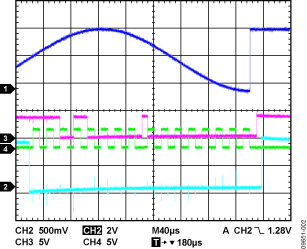
by Liam Riordan
View the original AN-1108 document posted to Analog.com.
This application note describes how to load a sinusoidal waveform on the output of the AD9832/AD9835 parts. This includes setting up the AD9832/AD9835 from a power-on scenario, setting up the FSELECT control bit, and loading new data to the part while using the FSELECT control bit.
When the AD9832/AD9835 is powered up, the part should be reset. This resets the appropriate internal registers to 0 to provide an analog output of full scale. To avoid spurious DAC outputs while the AD9832 is being initialized, the RESET bit should be set to 1 until the part is ready to begin generating an output. The RESET bit does not reset the phase, frequency, or control registers. These registers will contain invalid data, and, therefore, should be set to a known value by the user. The RESET bit should then be set to 0 to begin generating an output. The data appears on the DAC output seven to eight MCLK cycles after RESET is set to 0.
A simple example is best to explain how to program the AD9832 and the AD9835. For further details, refer to the AN-621 Application Note and the AD9832 or the AD9835 data sheet.
The aim is to generate two output frequencies, loading 3 kHz to the FREQ0 register, and 10 kHz to the FREQ1 register, with a 25 MHz MCLK.
The dial-up code for this is defined by the equation
For FREQ0 = 3000 Hz
= 515,396 decimal = 0x0007DD44
For FREQ1 = 10 KHz
= 1,717,987 decimal = 0x001A363E
Note that the ADIsimDDS tool offers a quick and easy method of generating the desired code in hexadecimal, decimal or binary.
The required initialization sequence is shown in Table 1.
Table 1. Initialization Sequence
| Hexadecimal | Binary |
|---|---|
| 0xD000 | 1101 0000 0000 0000 |
| 0x3044 | 0011 0000 0100 0100 |
| 0x21DD | 0010 0001 1101 1101 |
| 0x3207 | 0011 0010 0000 0111 |
| 0x2300 | 0010 0011 0000 0000 |
| 0x343E | 0011 0100 0011 1110 |
| 0x2536 | 0010 0101 0011 0110 |
| 0x361A | 0011 0110 0001 1010 |
| 0x2700 | 0010 0111 0000 0000 |
| 0x9000 | 1001 0000 0000 0000 |
| 0XC000 | 1100 0000 0000 0000 |
Use the register tables in the AD9832 or AD9835 data sheet for reference.
0xD000—Resets AD9832
RESET Bit D12 is set to 1. This resets the internal registers to 0, which corresponds to an analog output of full scale (see Figure 2). Ch1 is the spurious output set to reset. Ch2 is FSYNC, Ch3 is SDATA, and Ch4 is SCLK. Note that data is valid on the falling edge of SCLK. Ignore the SDATA high after eight SCLK cycles; this is an inherent feature of the particular SPI driver used and does not affect the part.
 <html> <center> </html>
Figure 2. Put AD9832/AD9835 in Reset--0xD000
<html> </center> </html>
<html> <center> </html>
Figure 2. Put AD9832/AD9835 in Reset--0xD000
<html> </center> </html>
0x3044
0x21DD
 <html> <center> </html>
Figure 3. Load 0x21DD
<html> </center> </html>
<html> <center> </html>
Figure 3. Load 0x21DD
<html> </center> </html>
0x3207—Frequency Register 0, L MSB data
0x2300—Frequency Register 0, H MSB data
0x343E—Frequency Register 1, L LSB data
0x2536—Frequency Register 1, H LSB data
0x361A—Frequency Register 1, L MSB data
0x2700—Frequency Register 1, H MSB data
0x9000—Set SELSRC to 1 using Command Bits 1:0 for C15 to C14.
0xC000—Frequency Register 1, L LSB data.
 <html> <center> </html>
Figure 4. Take Part Out of Reset--0xC000
<html> </center> </html>
<html> <center> </html>
Figure 4. Take Part Out of Reset--0xC000
<html> </center> </html>
The part is now set up with a 3 kHz signal on the output and is controllable by the FSELECT bit, as opposed to the FSELECT pin. To change this frequency to 10 KHz requires only a write to the control register to change the FSELECT bit.
0x5800—Selects the FREQ1 register.
To return to the 3 kHz FREQ0 output, reset the FSELECT bit to 0.
0x5800—Selects the FREQ0 register.
 <html> <center> </html>
Figure 5. Change FSELECT Bit--0x5800
<html> </center> </html>
<html> <center> </html>
Figure 5. Change FSELECT Bit--0x5800
<html> </center> </html>
The next step is to change the FREQ1 register from 10 kHz to 40 kHz without entering RESET mode.
= 6,871,948 decimal = 0x0068DB8C
Load the following command sequence:
 <html> <center> </html>
Figure 6. Changing FREQ1 Output from 10 kHz to 40 kHz
<html> </center> </html>
<html> <center> </html>
Figure 6. Changing FREQ1 Output from 10 kHz to 40 kHz
<html> </center> </html>